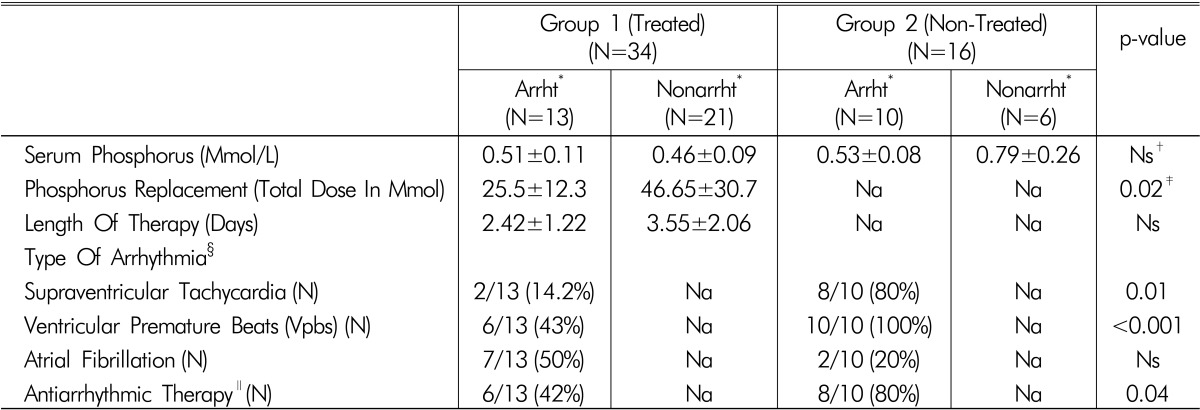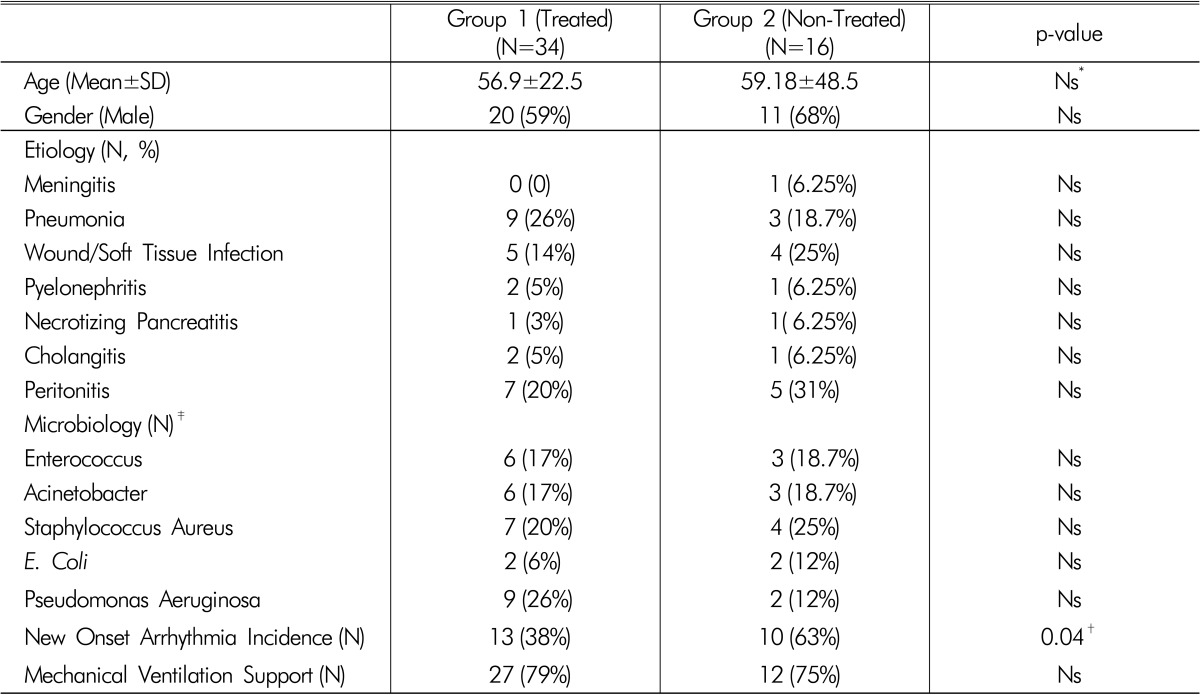1. Bender JS. Supraventricular tachycarrhythmias in the surgical intensive care unit: an under recognized event. Am Surg. 1996; 62:73–75. PMID:
8540651.
2. Goodman S, Weiss Y, Weissman C. A update on cardiac arrhythmias in the ICU. Curr Opin Crit Care. 2008; 14:549–554. PMID:
18787448.
3. Segun P, Signouret T, Laviolle B, Branger B, Mallédant Y. Incidence and risk factors of atrial fibrillation in a surgical intensive care unit. Crit Care Med. 2004; 32:722–726. PMID:
15090953.
4. Kirkpatrick JR, Heilbrunn A, Sankaran S. Cardiac arrhythmias: an early sign of sepsis. Am Surg. 1973; 39:380–382. PMID:
4710535.
5. Christian SA, Schorr C, Ferchau L, Jarbrink ME, Parrillo JE, Gerber DRJ. Clinical characteristics and outcomes of septic patients with new-onset atrial fibrillation. J Crit Care. 2008; 23:532–536. PMID:
19056018.

6. Meierhenrich R, Steinhilber E, Eggermann C, Weiss M, et al. Incidence and prognostic impact of new-onset atrial
fibrillation in patients with septic shock: a prospective observational study. Crit Care. 2010; 14:1–8.
7. Salman S, Bajwa A, Gajic O, Afessa B. Paroxysmal atrial fibrillation in critically ill patients with sepsis. J Intensive Care Med. 2008; 23:178–183. PMID:
18443011.
8. Annane D, Sébille V, Duboc D, et al. Incidence and prognosis of sustained arrhythmias in critically ill patients. Am J Respir Crit Care Med. 2008; 178:20–25. PMID:
18388358.

9. Brunelli SM, Goldfarb S. Hypophosphatemia; clinical consequences and management. J Am Soc Nephrol. 2007; 18:1999–2003. PMID:
17568018.

10. Barak Y, Schwartz A, Kalichman I, Nisman B, Gurman G, Shoenfeld Y. Prevalence of hypophosphatemia in sepsis and infection; The role of cytokines. Am J Med. 1998; 104:40–47. PMID:
9528718.

11. Shoenfeld Y, Hager S, Berliner S, Gallant LA, Pinkas J. Hypophosphatemia as diagnostic aid in sepsis. N Y State J Med. 1982; 82:163–165. PMID:
6952078.
12. Zazzo JF, Troche G, Ruel P, Maintenant J. High incidence of hypophophatemia in surgical intensive care patients. Efficacity of phosphorus treatment on myocardial function. Intensive Care Med. 1995; 21:826–831. PMID:
8557871.
13. Schwartz A, Gurman G, Cohen G, Gilutz H, Shenfeld Y. Association between hypophosphatemia and cardiac arrhythmias in the early stage of sepsis. Eur J Intern Med. 2002; 13:434–438. PMID:
12384132.
14. Dellinger RP, Levy HM, Carlet JM, Bion J, et al. International guidelines for management of severe sepsis and septic shock. Crit Care Med. 2008; 36:1394–1396.
15. Bollaert PE, Levy B, Nace L, Laterre PF, Larcan A. Haemodynamic and metabolic effects of rapid correction of hypophosphatemia in patients with septic shock. Chest. 1995; 107:1698–1701. PMID:
7781370.
16. O'Connor LR, Wheeler WS, Bethune JE. Effect of hypophosphatemia on myocardial performance in man. N Engl J Med. 1977; 297:901–903. PMID:
904668.
17. Geerse D, Bindela A, Kuiper AM. Treatment of hypophosphatemia in the intensive care unit. Review. Chest. 2010; 4:560–568.
18. El-Sherif N, Turitto G. Electrolyte disorders and arrhythmogenesis. Cardiol J. 2011; 18:233–245. PMID:
21660912.
19. Diercks DB, Shumaik GM, Harrigan RA, Brady WJ, Chan TC. Electrocardiographic manifestations: electrolyte abnormalities. J Emerg Med. 2004; 27:153–160. PMID:
15261358.

20. Shechter M. Magnesium and cardiovascular system. Magnes Res. 2010; 23:60–72. PMID:
20353903.
21. Knaus WA, Draper EA, Wagner DP, Zimmerman JE. APACHE II: a severity of disease classification system. Crit Care Med. 1985; 13:818–829. PMID:
3928249.
22. Vincent JL, de Mendonça A, Cantraine F, et al. Working group on "sepsis-related problems" of the European Society of Intensive Care Medicine. Use of the SOFA score to assess the incidence of organ dysfunction/failure in intensive care units: results of a multicenter, prospective study. Crit Care Med. 1998; 26:1793–1800. PMID:
9824069.







 PDF
PDF ePub
ePub Citation
Citation Print
Print



 XML Download
XML Download